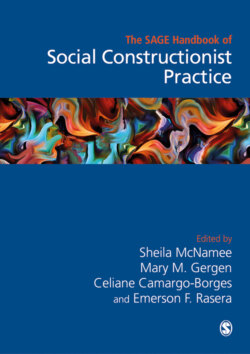Читать книгу The Sage Handbook of Social Constructionist Practice - Группа авторов - Страница 143
На сайте Литреса книга снята с продажи.
Zooming In: Hinge Practices
ОглавлениеFrom a practice perspective, we can zoom in to each of the socio-material hinge practices in a network to examine the doings, sayings, relatings, and actants (materials, place, and timespace). By ‘zooming in’ we attend closely to the details associated with accomplishing the practice. Doings are the actions of the practice, grounded materially in place and with things (actants). Sayings refer to what is said about the practice, the rationale for the practice, and what is said within the practice. Sayings are drawn from larger discourses or ways of understanding and doing the practice. Relatings are the emotional, embodied connections that glue the practice together. Relatings are teleoaffective and help describe how trajectories are formed within the practice towards continuation. Trajectories (telos = towards an aim, affective = feeling, emotion, embodied affect state) connect and perpetuate the practice in ways that become tacit. In Figure 10.5, we depict how doings (grounded socio-materially in things and place), sayings, and relatings comprise and sustain a practice.
Figure 10.5 Zooming in: gambling practices
For example, we can zoom in to examine the hinge practice of walking into a casino (Figure 10.6), which was highlighted in Tom Jackson's story as walking into a ‘different world’ (a ‘saying’ from a discourse of escapism). In Figure 10.6, we depict the socio-material practice of entering into this different world (casino), in contrast to the daily world he would like to shut out.
Figure 10.6 Hinge practice: walking into a casino
In this example, place and timespace of the casino are particularly important from a socio-material perspective. Tom Jackson has an embodied, affective relationship to the casino (place) that feels exciting and fun, and where he experiences a small ‘high’ with potential (i.e., telos) for an enormous high. In this hinge practice, the potential for an enormous high (teleoaffective relating) is networked with the desire to play the VLT (to achieve that high), which is another hinge practice (interacting with the VLT). This practice of interacting with a VLT (Figure 10.7) is grounded in the materiality of the VLT. The VLT is an important actant, the way in which it spins, the number of spins, how it is re-triggered, its timespace (2–3 mins), and the outcome (huge jackpot), all of which occurred alongside intense affective relatings (high, euphoria) which ‘made all that pain and depression go away’. These affective relatings became associated with the VLT through intensely positive affect. At the time of occurrence, and until deemed problematic, the sayings associated with this experience might centre on thrill, potential to win, excitement, and positive invitation to continue. In the retrospective account described here (after engagement in addiction treatment), Tom Jackson drew from an addiction discourse, when he likened his experience to cocaine or narcotics addiction (Figure 10.7).
Figure 10.7 Hinge practice: interacting with a VLT
In these network examples we were able to highlight the complexity of the practices and analytically focus in on material actants, which might be typically implicit or ignored in research. Zooming out allowed us to view these practices as relationally integrated and situated in networks of practices, while by zooming in to hinge practices we could zoom in closely on the details of the accomplishment of the practice.
